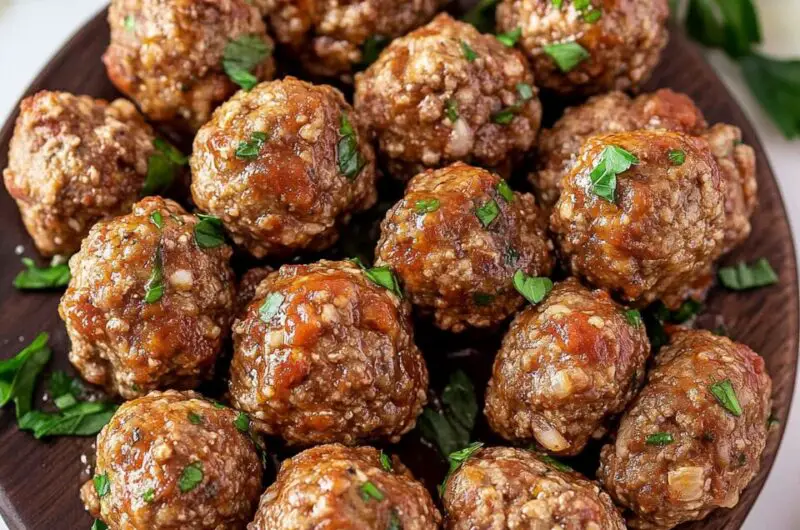The beauty of homemade meatballs lies in their simplicity and richness of flavor. These meatballs are soft on the inside with a perfectly seared crust, holding the bold essence of garlic, herbs, and a touch of love in every bite. Whether served over pasta, tucked into a crusty roll, or enjoyed solo, they never fail to deliver comfort and satisfaction. Making these from scratch gives you the flexibility to adjust seasoning to your preference and know exactly what’s going into your food. With ingredients you likely already have in your kitchen, these meatballs come together quickly, making them a reliable go-to recipe for busy weeknights or cozy Sunday dinners.
Full Recipe:
Ingredients:
-
1 lb ground beef
-
1/2 cup breadcrumbs
-
1/4 cup milk
-
1/4 cup finely chopped onion
-
2 cloves garlic, minced
-
1 egg
-
2 tablespoons chopped parsley
-
1/2 teaspoon salt
-
1/4 teaspoon black pepper
-
1/2 teaspoon dried oregano
-
1/2 teaspoon dried basil
-
Olive oil for cooking
-
Marinara sauce (optional for serving)
Directions:
-
In a small bowl, soak breadcrumbs in milk until softened, about 5 minutes.
-
In a large mixing bowl, combine ground beef, soaked breadcrumbs, onion, garlic, egg, parsley, salt, pepper, oregano, and basil. Mix just until combined avoid overmixing.
-
Roll the mixture into 1.5-inch balls and place them on a baking sheet.
-
Heat a large skillet over medium heat and add a bit of olive oil. Brown meatballs in batches until all sides are golden, about 6–8 minutes total.
-
Optional: Add the meatballs to a simmering pot of marinara sauce and cook for another 15–20 minutes to infuse flavor and ensure they’re fully cooked.
-
Serve over pasta, in a sub roll, or on their own with grated parmesan and fresh basil.
Prep Time: 15 minutes | Cooking Time: 25 minutes | Total Time: 40 minutes
Kcal: 290 kcal | Servings: 4 servings
The Ultimate Guide to Making Classic Homemade Meatballs
If there’s one dish that brings comfort, nostalgia, and delicious flavor together in every bite, it’s the classic homemade meatball. This beloved staple of Italian-American cuisine has found a place in kitchens and hearts around the world. Whether it’s served over spaghetti, nestled inside a crusty sub roll, or enjoyed solo with a splash of marinara, meatballs are versatile, satisfying, and deeply rooted in tradition. In this article, we’ll explore everything you need to know about classic homemade meatballs from the origins of the dish to tips for achieving perfect texture and flavor every time.
A Brief History of the Meatball
The origins of meatballs can be traced back to ancient times, with early versions appearing in various cultures around the globe. In the Middle East, kofta made from ground meat and spices is still widely popular. Similarly, Chinese cuisine has its own version called “lion’s head meatballs,” while Swedish meatballs are a hallmark of Scandinavian fare.
The Italian version, polpette, often features a blend of meats, breadcrumbs, herbs, and sometimes cheese. Unlike American-style meatballs, Italian polpette are typically smaller and served without pasta, often as a second course or appetizer. The version that most Americans are familiar with larger meatballs simmered in tomato sauce and served with spaghetti is a creation that took shape in the United States in the early 20th century, as Italian immigrants adapted their culinary traditions to locally available ingredients and cultural preferences.
Why Homemade Meatballs Are Worth the Effort
Although it’s easy to find pre-made meatballs at the grocery store, nothing compares to the taste and texture of homemade. When you make your own meatballs, you control every element from the quality of meat and type of seasoning to the cooking method. This flexibility allows you to create a dish that’s perfectly tailored to your family’s tastes and dietary needs.
Homemade meatballs are also more economical than store-bought alternatives, especially when you make them in bulk and freeze extras for later. You can also avoid unnecessary additives and preservatives, opting instead for wholesome ingredients.
Key Elements of the Perfect Meatball
Achieving the perfect meatball involves balancing flavor, texture, and moisture. Here are some important aspects to keep in mind:
1. Meat Choice
Traditional meatballs use ground beef, but many cooks opt for a blend of beef, pork, and veal for added complexity and tenderness. If you’re looking for a leaner option, ground turkey or chicken can be used, though they may require extra attention to seasoning and moisture.
2. Breadcrumbs and Binders
Breadcrumbs act as fillers that absorb moisture and keep the meatballs from becoming dense. Mixing them with milk or broth before adding to the meat mixture creates a panade, which improves the texture and ensures the meatballs remain tender and juicy.
3. Aromatic Additions
Onion, garlic, herbs like parsley and basil, and dried seasonings such as oregano and black pepper are essential for building flavor. Some recipes also include grated Parmesan or Romano cheese for an extra umami punch.
4. The Right Technique
Mix the ingredients gently overworking the meat can make your meatballs tough. Shaping them evenly ensures consistent cooking, and using a scoop can help with uniform size.
Cooking Methods: Which One is Best?
There are several popular ways to cook meatballs, each offering its own benefits:
1. Pan-Frying
This method gives the meatballs a crisp, golden crust and rich flavor. It requires careful attention to prevent sticking or burning but delivers excellent results. Pan-fried meatballs can be finished in sauce to absorb additional flavor.
2. Baking
Baking is less hands-on and can be more consistent, especially when cooking a large batch. It produces a drier exterior but allows you to cook multiple meatballs at once without constant monitoring.
3. Simmering in Sauce
Some cooks skip pre-cooking entirely and simmer raw meatballs directly in sauce. This results in exceptionally tender meatballs that absorb the richness of the sauce, though they may lack a crusty exterior.
4. Combination Approach
Many recipes call for pan-searing or baking first, then finishing the meatballs in tomato sauce. This offers the best of both worlds: a flavorful crust and a soft, moist interior.
Serving Suggestions
Classic homemade meatballs are incredibly versatile and can be served in a variety of ways. The most iconic pairing is with spaghetti and marinara sauce a beloved dish that’s become symbolic of Italian-American cuisine.
Other ideas include:
-
Meatball subs with melted mozzarella and toasted rolls
-
Served over creamy polenta or mashed potatoes
-
As a protein-rich topping for pizza
-
On their own as appetizers, with toothpicks and dipping sauces
-
Stuffed into pita bread with tzatziki for a Mediterranean twist
They also pair well with side dishes like garlic bread, Caesar salad, or roasted vegetables.
Storage and Make-Ahead Tips
One of the best things about meatballs is their freezer-friendliness. You can prepare a large batch, cook them, and freeze for up to three months. This makes weeknight dinners a breeze just thaw and reheat in sauce or the oven.
To freeze meatballs:
-
Let them cool completely after cooking.
-
Arrange on a baking sheet and freeze until firm.
-
Transfer to a freezer-safe bag or container and label with the date.
For best results, reheat them gently in simmering sauce or in the oven to retain moisture.
Healthier Variations
If you’re watching your diet, there are plenty of ways to make healthier meatballs:
-
Lean meats: Choose ground turkey or chicken instead of beef or pork.
-
Whole grain breadcrumbs: Substitute traditional breadcrumbs for whole wheat versions.
-
Vegetable add-ins: Add grated zucchini, carrots, or spinach for extra fiber and nutrients.
-
Baking instead of frying: Skip the added oil and bake your meatballs for a lighter option.
You can also experiment with plant-based versions using lentils, chickpeas, or textured vegetable protein for vegetarian and vegan alternatives.
Conclusion:
Homemade meatballs are more than just a meal they’re a warm, hearty expression of comfort food that transcends cultures and generations. Making them from scratch allows you to create a dish that reflects your culinary preferences, with endless opportunities for customization and flavor exploration.
Whether you’re a novice home cook or a seasoned chef, mastering the classic meatball opens the door to countless recipes and mealtime memories. Keep a stash in the freezer, serve them with your favorite sides, and enjoy the satisfaction of a meal that’s both traditional and endlessly adaptable.
So next time you’re in the kitchen and craving something cozy, roll up your sleeves and whip up a batch of these classic homemade meatballs. Your taste buds and your family will thank you.








